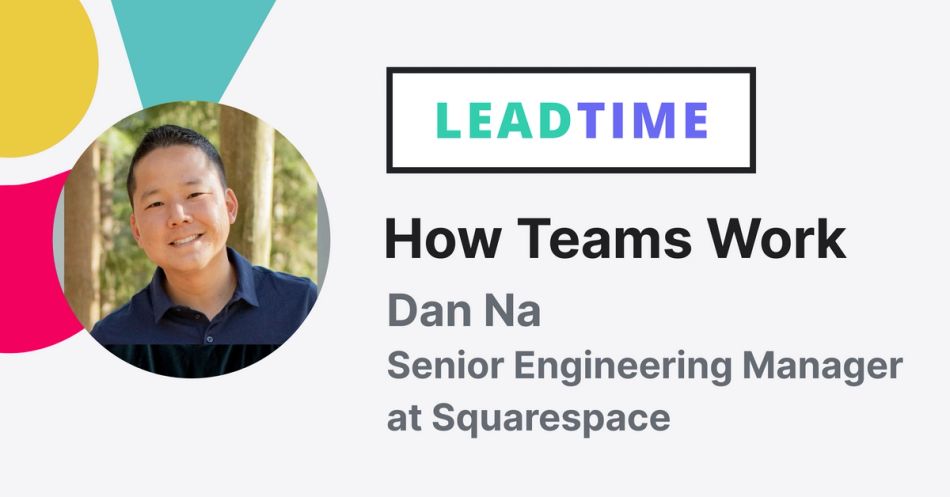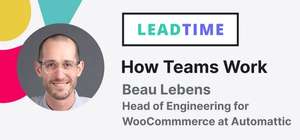
Leading a team, especially a distributed or growing one, can be hard. Oftentimes the best advice and ideas come from other teams just like yours. That’s why we launched Lead Time: How Teams Work.
This blog series profiles real teams, how they’re structured, and how they communicate through meetings and other touchpoints. Plus, each article features a top-notch leader who's got proven tips and real stories to learn from.
Meet Dan Na — senior engineering manager at Squarespace
Dan Na is a senior engineering manager for Squarespace’s international engineering teams, a cross-functional group of 14 consisting of an engineering manager, engineers, a product manager, a designer, and a technical program manager.
Their shared focus is on internationalization, but they’re split into two teams: product and platform.
The product team builds user-facing features for localization, like a multilingual extension for CMS websites, while the platform group works on shared tooling, code libraries, and workflows that enable engineers across the company to localize their work.
We recently spoke with Dan to learn about his team’s recent shift to hybrid work.
Follow Dan Na on Twitter or his blog to catch more insights from his journey.
The move to hybrid work
Dan’s teams operate under a hybrid work model, with half of the group working in the office and half working remotely.
Prior to the pandemic, they were mostly in-office. Dan says their shift to hybrid has taken greater intention, especially when it comes to getting communication and connection right.
Dan says: “Covid has been lonely for a lot of people who once were in the office and now are not, which is why we bias towards more face-to-face opportunities to meet. I still believe in asynchronous workflows, but want to accommodate the emotional and mental needs of my team at this time.”
What meetings look like on Dan’s hybrid team
As far as regular meetings go, Dan’s teams operate using the agile process—with daily standups, sprint and backlog grooming, and a monthly retro.
Everyone from the team logs in from their laptop—even if they're working in the office—to make the hybrid meetings more remote-inclusive.
“As our team’s grown, we’ve adopted new practices to make things more inclusive of our remote teammates. Everyone logs into standup from their laptop, and technical planning happens digitally, instead of on physical whiteboards," Dan says.
When remote teammates mentioned they felt socially disconnected from the team, Dan added more intentional moments for connection to the mix too. (All of which are optional to attend.)
Scheduled team-building time for hybrid teams
- Two 30-minute free-form social meetings each week
- A weekly “team enrichment” hour, where they read and discuss an article together
- Peer-to-peer 1:1s
“Peer 1:1s are opt-in and the cadence is 100% self-determined, but I'd say almost everyone has a 1:1 with everyone else at least once a month. It’s paid significant dividends for team morale.”
Dan’s top leadership tips
Meeting discipline matters
While their meeting calendar is fairly lean, Dan takes an opposite approach to many leaders on remote and hybrid teams. He found his team prefers meetings over async communication in many cases—especially to improve connection since the pandemic.
“I've found that face time has been key for maintaining a sense of interconnectedness as a distributed team. We tried Slack updates in lieu of stand-ups but stopped them for this reason.”
To avoid meeting overload with this approach though, Dan says you have to get really disciplined with your meeting culture.
“Meetings should serve one (or both) of two goals: (1) build culture, or (2) push forward a technical outcome. As someone with increasingly limited calendar bandwidth, I have low tolerance for meetings that don't generate value consistent with those goals. As a result, meeting discipline becomes just as important as meeting purpose or frequency.”
He shared the following framework for how he thinks about this.
Dan’s meeting discipline framework
- Set a relevant and specific meeting title
- Send invites to those you'd value/expect feedback from, and send optional invites to those who may be peripherally interested but are truly optional
- Always prepare and attach a pre-read doc that provides enough context to allow invitees to self-determine if they’re in fact appropriate for this meeting (pre-read context can vary from literally one sentence to an entire multi-page RFC)
- Organize your meeting docs in a shared folder or place where everyone can find it—nothing’s worse than losing valuable notes into the abyss
- Take meeting notes, or kindly ask someone else to (I recommend keeping a transcript as best you can, prefacing speakers with their initials: [DN] Said to take notes)
Use a time boxed agenda and facilitate the conversation with the end goal or desired meeting outcome in mind
⭐️ For more help setting meeting agendas and taking meeting notes, check out these Range meeting templates.
“If I had to describe our meeting culture in a single term I'd choose ‘high-value.’ I find few things burn out well-meaning people more than meetings that feel like a waste of time.”
Try something once
When evaluating potential process improvements, it's easy to get bogged down by all the reasons something won't work. But it’s also near impossible to anticipate what will resonate, and sometimes it might surprise you.
“The value of a given process can vary so much based on personalities, seniority, burnout levels, larger changes in the world, etc. Consequently I think a willingness to try new processes once ultimately pays off.”
Dan’s “try something once” philosophy has helped the team unlock improvements they might not have otherwise, and keeps the door open for everyone to take ownership of team processes.
My team knows that if they offer feedback or a suggestion, I’ll treat it seriously. Some of these suggestions have worked and some haven’t, but I value fostering an environment that allows teams to demonstrate ownership over their own workflows.”
He recommends leaders approach process improvements with a flexible and responsive mindset. It’s about iteration, not getting it perfect every single time.
Looking for inspiration for your next round of process improvements? Find out what other leaders are trying.








